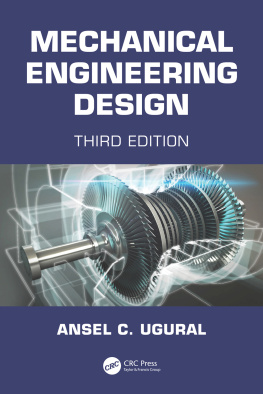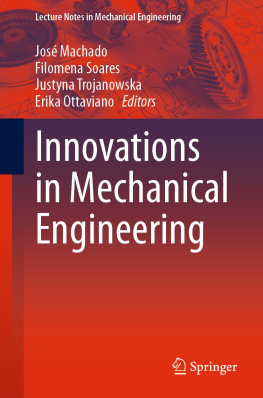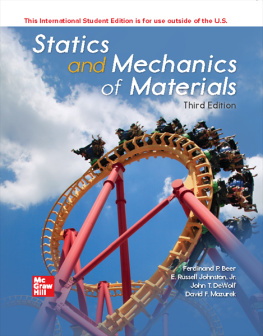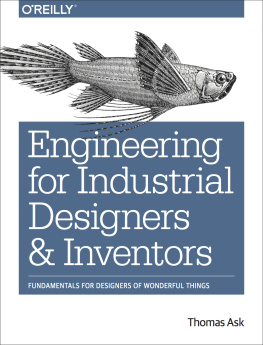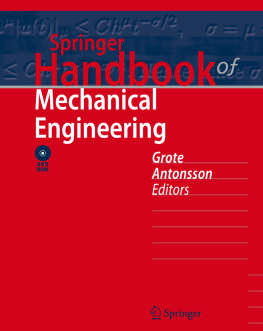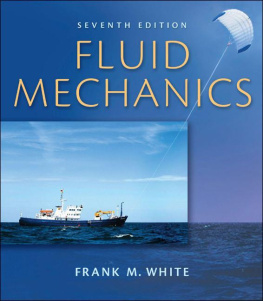Mechanical Engineering Design
Mechanical Engineering Design
Third Edition
Ansel C. Ugural
with Contributors
Youngjin Chung Errol A. Ugural

MATLAB is a trademark of The MathWorks, Inc. and is used with permission. The MathWorks does not warrant the accuracy of the text or exercises in this book. This books use or discussion of MATLAB software or related products does not constitute endorsement or sponsorship by The MathWorks of a particular pedagogical approach or particular use of the MATLAB software.
by CRC Press
6000 Broken Sound Parkway NW, Suite 300, Boca Raton, FL 33487-2742
and by CRC Press
2 Park Square, Milton Park, Abingdon, Oxon, OX14 4RN
2021 Taylor & Francis Group, LLC
First edition published by McGraw-Hill 2004
Second edition published by CRC Press 2015
CRC Press is an imprint of Taylor & Francis Group, LLC
Reasonable efforts have been made to publish reliable data and information, but the author and publisher cannot assume responsibility for the validity of all materials or the consequences of their use. The authors and publishers have attempted to trace the copyright holders of all material reproduced in this publication and apologize to copyright holders if permission to publish in this form has not been obtained. If any copyright material has not been acknowledged please write and let us know so we may rectify in any future reprint.
Except as permitted under U.S. Copyright Law, no part of this book may be reprinted, reproduced, transmitted, or utilized in any form by any electronic, mechanical, or other means, now known or hereafter invented, including photocopying, microfilming, and recording, or in any information storage or retrieval system, without written permission from the publishers.
For permission to photocopy or use material electronically from this work, access www.copyright.com or contact the Copyright Clearance Center, Inc. (CCC), 222 Rosewood Drive, Danvers, MA 01923, 978-750-8400. For works that are not available on CCC please contact mpkbookspermissions@tandf.co.uk.
Trademark notice : Product or corporate names may be trademarks or registered trademarks, and are used only for identification and explanation without intent to infringe.
ISBN: 978-0-367-51347-4 (hbk)
ISBN: 978-1-003-09928-4 (ebk)
Typeset in Times
by Deanta Global Publishing Services, Chennai, India
Contents
Introduction
This book was developed from classroom notes prepared in connection with juniorsenior undergraduate courses in mechanical design, machine design, mechanical engineering design, and engineering design and analysis. The scope of this book is wider than any other book on the subject. In addition to its applicability to mechanical engineering , and to some extent, aerospace, agricultural, and nuclear engineering, and applied engineering mechanics curricula, I have endeavored to make the book useful to practicing engineers as well . The book offers a simple, comprehensive, and methodical presentation of the fundamental concepts and principles in the design and analysis of machine components and basic structural members. The coverage presumes knowledge of the mechanics of materials and material properties. However, topics that are particularly significant to understanding the subject are reviewed as they are taken up. Special effort has been made to present a book that is as self-explanatory as possible, thereby reducing the work of the instructor.
The presentation of the material in this book strikes a balance between the theory necessary to gain insight into mechanics and the design methods. I, therefore, attempt to stress those aspects of theory and application that prepare a student for more advanced study or professional practice in design. Above all, I have made an effort to provide a visual interpretation of equations and present the material in a form useful to a diverse audience. The analysis presented should facilitate the use of computers and programmable calculators. The commonality of the analytical methods needed to design a wide variety of elements and the use of computer-aided engineering as an approach to design are emphasized.
Mechanical Engineering Design provides unlimited opportunities for the use of computer graphics. Computer solutions are usually preferred because the evaluation of design changes and what-if analyses require only a few keystrokes. Hence, many examples, case studies, and problems in the book are discussed with the aid of a computer. Generally, solid modeling serves as a design tool that can be used to create finite element (FE) models for analysis and dynamic simulation. Instructors may use a simple PC-based FE program to give students exposure to the method applied to stress concentration and axisymmetrically loaded and plane stress problems. The website for the book (see Optional Media Supplements, page xxii) allows the user to treat problems more realistically and demonstrates the elements of good computational practice. The book is independent of any software package.
Traditional analysis in design, based on the methods of mechanics of materials, is given full treatment. In some instances, the methods of the applied theory of elasticity are employed. The role of the theory of elasticity in this book is threefold: it places limitations on the application of the mechanics of materials theory, it is used as the basis of FE formulation, and it provides exact solutions when configurations of loading and component shape are simple. Plates and basic structural members are discussed to enable the reader to solve real-life problems and understand interactive case studies. Website addresses of component and equipment manufacturers and open-ended web problems are given in many chapters to provide the reader access to additional information on those topics. Also presented is finite element analysis (FEA) in computer-aided design. The foregoing unified methods of analysis give the reader the opportunity to expand his or her ability to perform the design process in a more realistic setting. The book attempts to fill what I believe to be a void in the world of textbooks on mechanical design and machine design.
The book is divided into three sections. The basics of loading, stress, strain, materials, deflection, stiffness, and stability are treated first. Then fracture mechanics, failure criteria, fatigue phenomena, and surface damage of components are dealt with. These are followed by applications to machine and miscellaneous mechanical and structural components. All the sections attempt to provide an integrated approach that links together a variety of topics by means of case studies. Some chapters and sections in the book are also carefully integrated through cross-referencing. Throughout the book, most case studies provide numerous component projects. They present different aspects of the same design or analysis problem in successive chapters. Case studies in the preliminary design of two machines are taken up in the last chapter.
Attention is given to the presentation of the fundamentals and necessary empirical information required to formulate design problems. Important principles and applications are illustrated with numerical examples, and a broad range of practical problems are provided to be solved by students. This book offers numerous worked-out examples and case studies, aspects of which are presented in several sections of the book; many problem sets, most of which are drawn from engineering practice; and a multitude of formulas and tabulations from which design calculations can be made. Most problems can be readily modified for in-class tests. Answers to selected problems and References (identified in square brackets ) are given at the end of the book.

